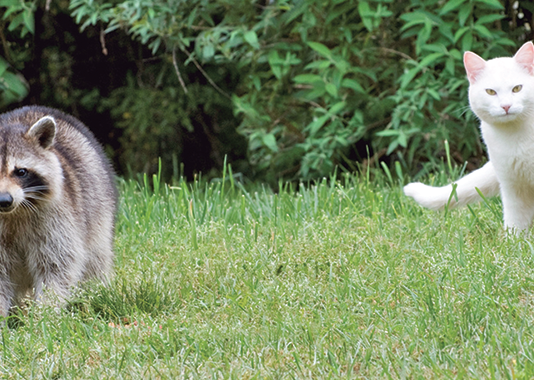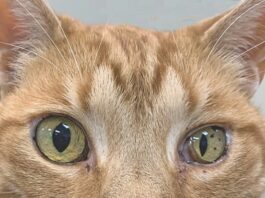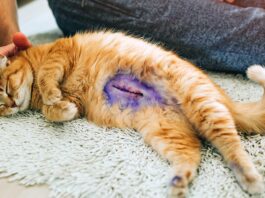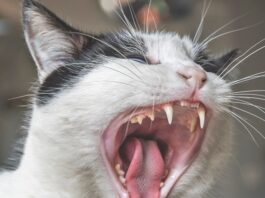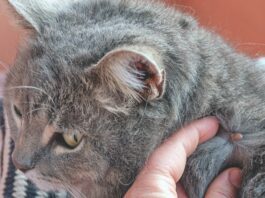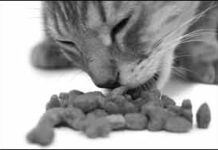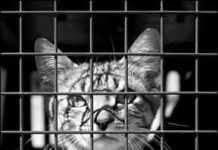Cuterebra Infestation Can Be Deadly
Most owners know the parasites that can bedevil their cats, including fleas, ticks, mites and an abundance of worms. A lesser-known parasite, with far greater impact, is cuterebra (kyüt-ә-`rç-brә). They’re larva from adult botflies that can burrow under a cat’s skin or, more alarmingly, enter through the nose and migrate to the brain. The threat of infestation is not widely known for two reasons, says parasitologist Dwight Bowman, Ph.D., professor in the Department of Microbiology and Immunology at Cornell University College of Veterinary Medicine. “It tends to be more rural than urban and suburban.” And the flies are prevalent only in the Western and Northeast U.S., and Southeastern Canada.
A Commitment to Improving Well-being
Imagine veterinarians being able to sterilize feral cats by vaccination instead of surgery. Or to identify the connection between a relatively benign form of feline coronavirus and feline infectious peritonitis, which is nearly always fatal, with the hope of finding ways to diagnose and combat it. Or discover how and why vaccine-associated sarcomas may trigger DNA damage in some cats and how this damage may be used to predict which cases of the sarcomas are amenable to chemotherapy. These are just three of the many scientific studies funded by the Cornell Feline Health Center where, under the guidance of Director Colin Parrish, Ph.D., Professor of Virology, the goal of bettering the health of cats continues to be the focus and commitment, as it has been since the center opened its doors in 1974.
Short Takes: September 2012
Biologists at the Royal Veterinary College in London may have discovered the reason for the cheetah’s record as the fastest living land mammal. Researchers at the college’s Structure and Motion Laboratory compared the cheetah’s gait to that of racing Greyhounds, whose speed tops out at 37 miles per hour. The big cats have been clocked at 64 miles per hour. “Cheetahs and Greyhounds are known to use a rotary gallop [in which the limbs fall in circular sequence around the body] and physically they are remarkably similar, yet there is this bewitching difference in maximum speed,” says researcher Alan Wilson, Bsc., Ph.d.
Is it Normal Shedding or Hair Loss?
With the exception of hairless breeds such as the Sphynx, cats are known for their furry pelts, so if a cat starts to lose his coat, it’s justifiably cause for concern. How can you distinguish between normal shedding and abnormal hair loss? It’s easy: Shedding doesn’t cause bald spots. If the skin is visible, best to schedule a veterinarian exam or ask for a referral to a dermatologist. Hair loss, or alopecia, takes two main forms, says dermatologist William H. Miller, VMD, Medical Director of the Companion Animal Hospital at Cornell University College of Veterinary Medicine: “The hairs fall out spontaneously.” Though it’s a rare occurrence, spontaneous hair loss can be related to stress, endocrine diseases such as Cushing’s disease (an overproduction of cortisol by the adrenal glands), hyperthyroidism (excess production of the thyroid hormones), and some forms of cancer, including lymphoma, liver or pancreatic cancer.
Broken Bones: All Cats Are at Risk
Despite their typically strong, agile, and resilient bodies, cats are subject to a wide variety of musculoskeletal disorders — diseases and injuries affecting the complex structure of bones, muscles, tendons, and ligaments that give shape to their bodies and enable them to move about. Fortunately, most of these disorders — such as congenital malformations, inflammatory diseases and tumorous growths — are relatively rare in cats. Less rare by comparison are bone fractures that result from traumatic events, such as when a cat is hit by a car, for example, or falls from a tree. A fracture can occur when any physical force applies sudden and excessive pressure on a bone until it snaps at its weakest point. Although fractures occur less frequently in felines than they do in dogs, cats with broken bones are treated once or twice each month at the Cornell University Hospital for Animals (CUHA), according to Ursula Krotscheck, DVM, an assistant professor of clinical sciences at the University’s College of Veterinary Medicine.
Trial uses stem cells to treat kidney Disease
Researchers at Colorado State University College of Veterinary Medicine are testing a new treatment for a common problem in aging cats. They’re using stem cells in an effort to better manage chronic kidney disease. “In our clinical trial, we are seeing if stem cells can improve renal function, decrease inflammation and scarring in the kidney, and improve levels of excess protein in the urine,” says Jessica Quimby, DVM, who’s working with a team of team of veterinarians and researchers at the school.
When to Worry About Tail Injuries
A cat’s tail can wave happily, swish angrily and wrap around him contentedly. But when the tail is injured, more may be at stake than the ability to communicate mood. Injuries to the feline tail may be minor, causing a brief spasm of pain or a permanent crook, or they may damage the nerves so severely that bladder and sphincter control are affected temporarily or permanently. Common injuries include fractures, acute trauma that may involve damage to the skin or heavy bleeding, and what are known as avulsion injuries, caused by pulling, says board-certified surgeon James A. Flanders, DVM, Associate Professor at Cornell University’s College of Veterinary Medicine. Tails can also be damaged if they are bitten in a fight with another animal.
The Future Basis For Diet Plans: Genetics
Nutritionist Joseph Wakshlag, DVM, Associate Professor of Clinical Nutrition at Cornell University College of Veterinary Medicine, poses a question for owners: “If you knew that your cat would develop cognitive dysfunction at age 12, and if feeding him an antioxidant-enhanced diet would delay that development, wouldn’t you do it?” That scenario may be possible in the not-too-distant future. If scientists identify a gene for feline cognitive dysfunction — and a host of other diseases with genetic risk factors — individualized nutrition and lifestyle plans could be developed for cats based on their genetic tests. It has long been known that nutrition plays an important role in preventing and healing disease in humans, cats and dogs, but its role may be greater than we thought. Researchers in the pioneering science of nutrigenomics stand squarely at the intersection of genetics and nutrition.
Short Takes: October 2012
Two specialists in veterinary emergency and critical care have teamed up to help produce the first evidence-based guidelines for cardiopulmonary resuscitation in cats and dogs. When a preliminary survey showed little consistency in the rate of chest compressions administered by veterinarians during CPR, Daniel J. Fletcher, DVM, Ph.D., at Cornell and Manuel Boller, DVM, MTR, at Penn initiated a plan to develop evidence-based guidelines for CPR for veterinary patients. Although more than 20 percent of human patients who suffer cardiac arrest in the hospital survive to go home, perhaps partially as a result of the variability in compression rate, only 6 percent of dogs and cats do, according to recent veterinary CPR research.
Looking Beyond the Food Bowl
Bringing out the nutritional best in your cat goes beyond the food in the bowl. Frequency of meals, location, post-meal bowl cleaning and other environmental factors also influence his health. “One of the biggest problems is that far too many people overfeed their cats, and the cats become overweight and some even become obese,” says nutritionist Joseph Wakshlag, DVM, Ph.D., Associate Professor of Clinical Nutrition at Cornell University College of Veterinary Medicine. “Dogs give you those begging eyes when you sit down to eat, but in most cases, you can get them to go into another room and leave you alone.” They excel at begging. “Cats, however, are aggressive beggars. They will keep purring and meowing. If you tell them to go away, they will just come right back and start meowing again. They are more persistent than dogs and far too often, the person gets frustrated and will get up and put more food in their bowls.”
Ask Elizabeth: September 2012
I work at a large no-kill animal sanctuary with special-needs cats. Often when one becomes ill and stops eating, we tempt him or her with people food like baby food or boiled chicken. I have heard a lot of conflicting things about feeding cats baby food or straight meat. Someone recently told me that a good all-meat baby food and straight chicken are nutritionally complete, but I have read in a few places that cats need other nutrients like taurine and vitamins A and D or they will get very sick. Does straight meat provide full nutrition for cats? In the wild, how do cats get full nutrition if meat does not provide it all? What is the best kind of food for our dear kitties?
Understand the Risk of Glaucoma
The eye is an amazing, delicate organ. Cells within the eye normally produce a clear fluid (aqueous humor) that serves to nourish and maintain the shape of the eye. When the balance between the production and the drainage of fluid is upset, glaucoma can result. Decreased drainage of fluid causes increased pressure (and pain) within the eye, often resulting in damage to the optic nerve and, consequently, loss of vision. While glaucoma is much less common in cats than in dogs, it still poses the same high risk of blindness if left untreated. In fact, even if diagnosed early on, treatment is not always successful.

